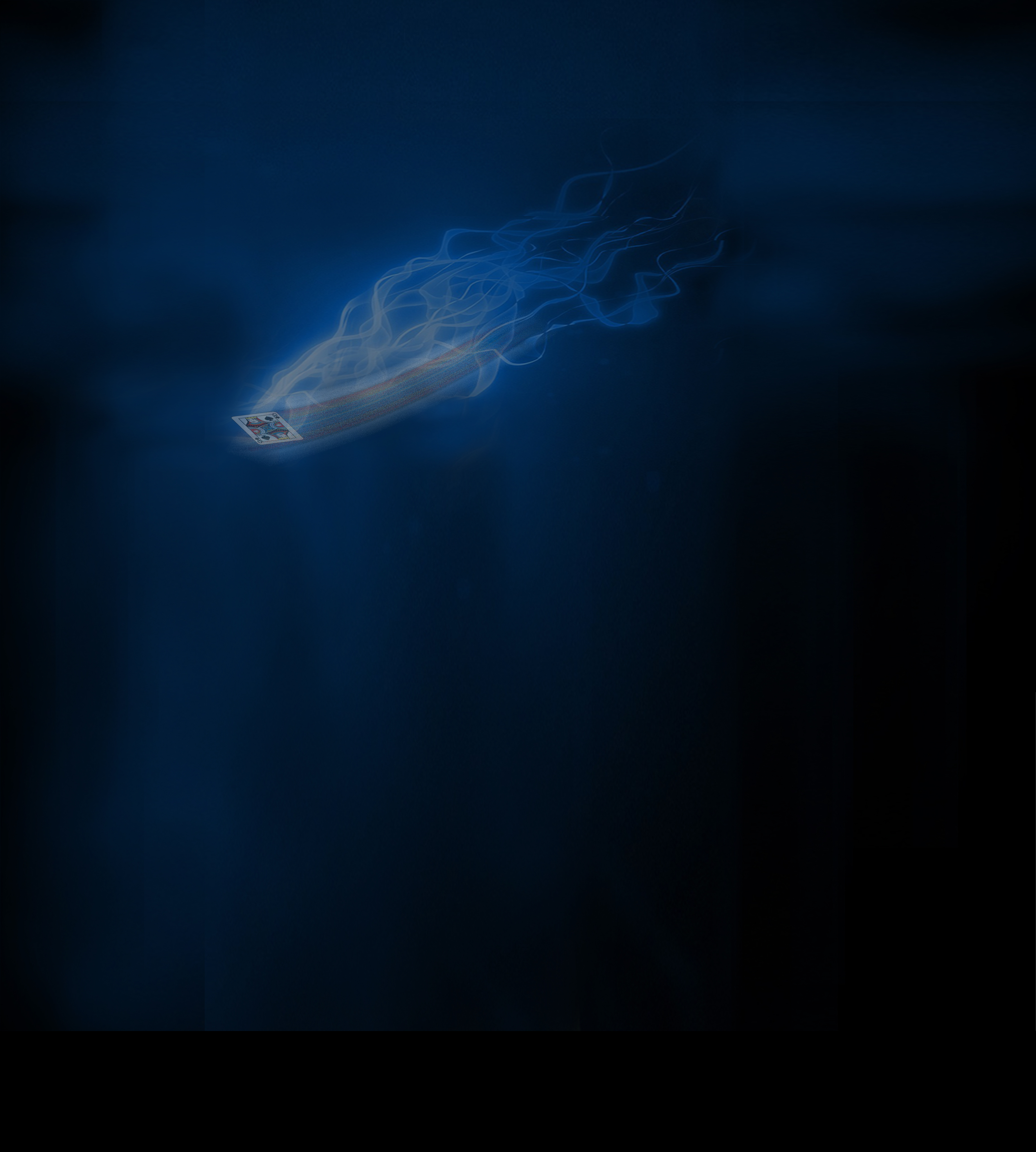
Archeologists in Pompeii announce latest find on Valentine's Day -
Published: February 2019
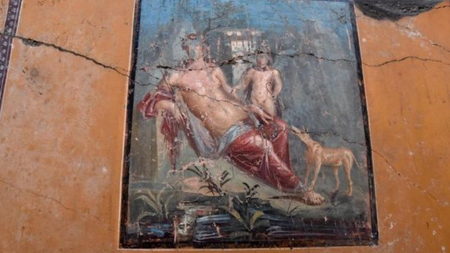
a fresco of Narcissus, who loved only himself.
Read the full story
Adolf Hitler paintings of 'no artistic value' on sale in Berlin
Published: January 2019
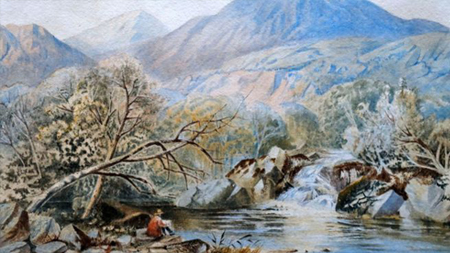
Three watercolour paintings attributed to the former German Nazi leader Adolf Hitler are being auctioned in Berlin.
The watercolours were created in the early 20th Century while Hitler, later guilty of some of the worst crimes in history, worked as a painter in Munich..
Étienne Terrus museum in Elne uncovers fake art in collection
Published: 8th of May 2018
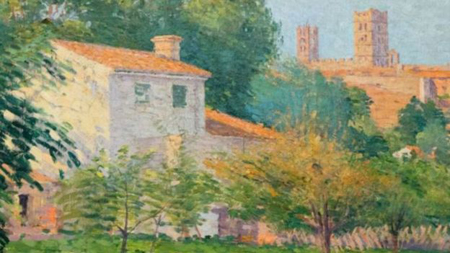
More than half of the paintings in a museum in French artist Étienne Terrus' birthplace were fake.
Read the full story
The Secrets of Girl with Pearl Earring
Published: 5th of May 2018
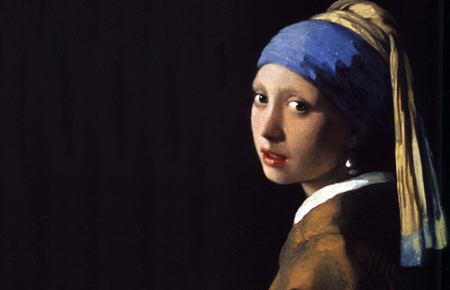
A new research project at the Mauritshuis in The Hague hopes to unlock some of the mysteries that surround Vermeer’s masterpiece.
A new research project led by the Mauritshuis museum in The Hague – where Girl with a Pearl Earring is a star attraction – hopes to address some of the questions that exist, about how she was painted, the materials used and what Vermeer himself intended..
Stolen Marc Chagall painting to be returned after 30 years
Published: 3rd of May 2018
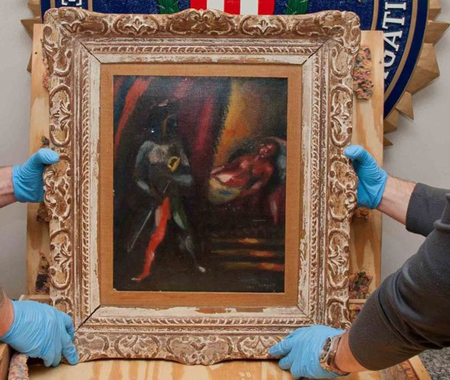
The FBI recovered the 1911 oil painting, stolen from a New York couple in 1988, last year in Maryland.
The 1911 painting, Othello and Desdemona, was taken from Ernest and Rose Heller's flat with more than a dozen other works of art and jewellery.
The Chagall was recovered last year after a Washington, DC gallery owner twice refused to purchase the painting.
He told the seller to contact the authorities for proof of ownership.
"We took the case from there," said Special Agent Marc Hess, a member of the FBI Art Crime Team.
New scanning technique reveals secrets behind great paintings
Published: 14th of March 2018
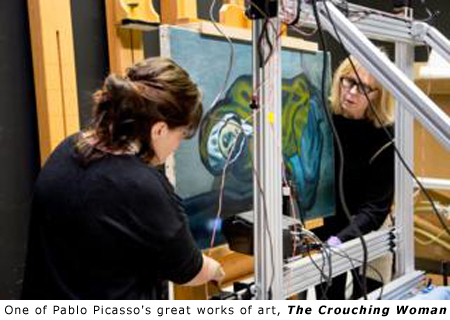
This new x-ray fluorescence instrument could lead to increase in the number of paintings investigated
Underneath the oil painting is a landscape of Barcelona which, it turns out, Picasso used as the basis of his masterpiece.
The new x-ray fluorescence system is cheaper than alternative art scanning systems - and it is portable, making it available to any gallery that wants it.
Details were revealed at the annual meeting of the American Association for the Advancement for Science in Austin, Texas.
How my grandmother woke the genius of Picasso
Published: 10th of March 2018
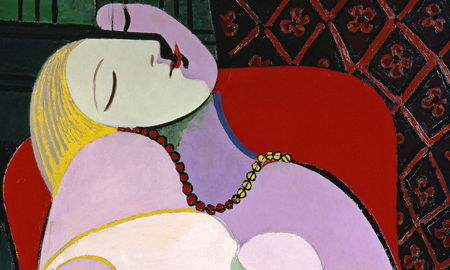
Olivier Widmaier Picasso remembers his grandmother’s secret life with the great artist
On Saturday 8 January 1927, in the late afternoon, my grandfather noticed a young woman through the window of the Galeries Lafayette in Paris. He waited until she came out, then greeted her with a big smile. “Mademoiselle, you have an interesting face. I would like to paint your portrait.” He added: “I’m sure we shall do great things together. I’m Picasso,” pointing, by way of introduction, at a large book about himself. “I would like to see you again. I’ll meet you at 11 o’clock on Monday in Saint-Lazare Métro station.” Marie-Thérèse Walter, my future grandmother, had just met the love of her life. And Picasso had been reborn.
Saint shot by Nazis
Published: 16th of January 2018
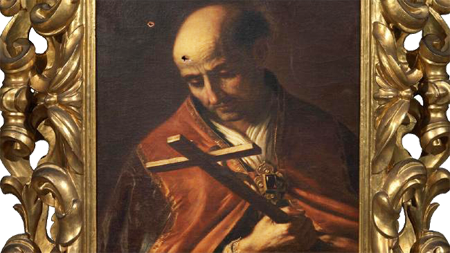
The Corsini collection saved -
Now On Tour in Australia
‘Madam, your collection is not worth my life,” said the terrifie¬d servant to Donna Elena Corsini in August 1944 when she asked him to drive a truck filled with the Florentine -family’s artworks away from the advancing German army to her family’s country villa.
When the servant refused, a resolute Donna Elena clambered behind the steering wheel and drove the Corsini family’s precious works to safety. At the villa, she ordered the hasty installation of a false wall; behind it, the precious paintings were hidden and sealed in.
A large oil painting of Saint Andrea Corsini, the family’s beatified relative, was hung on the inside wall as a kind of talisman to protect the collection.
“They created a false wall before the German army passed through and occupied the farm for a couple of days,” says Stefano Carboni, ¬director of the Art Gallery of Western Australia, where the saint’s image will go on display this week as part of The Corsini Collection: A Window on Renaissance Florence.
“But a German lieutenant could smell that the plaster was still wet, which was odd,” says Carboni, “and in frustration he shot a couple of bullets into the false wall.” One of the bullets pierced the painted forehead of the saint, ¬although, according to family lore, he saved the rest of the collection.
,
Modigliani Fakes
Published: 16th of January 2018
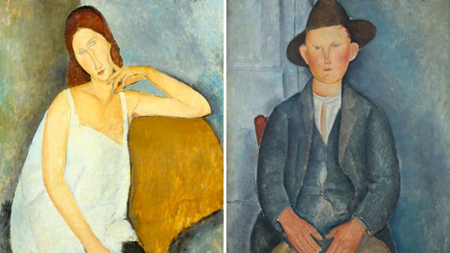
Italian police investigate organisers of fake Modigliani show
Italian police are investigating three organisers of a Modigliani exhibition after all but one of the paintings were shown to be fake.
The exhibition opened to great fanfare in Genoa last March, but closed in July after experts raised suspicions that the works were forgeries.
Art historians have now concluded that 20 of the paintings are indeed fakes.
Amedeo Modigliani's work often fetches huge sums, but experts say he's one of the most copied artists in the world.,
Out of the Fog
Published: 18th of December 2017
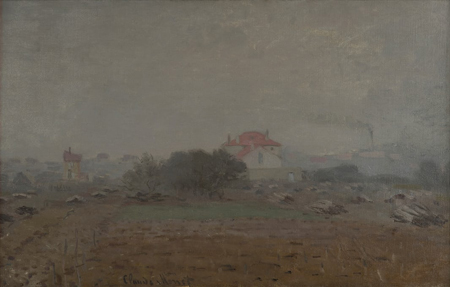
Missing Monet found through the power of the web
Painting of artist’s rural retreat, unseen in exhibition since 1895, will now go on show at National Gallery Tracking down lost works of art usually involves poring over obscure documents in galleries, archives and libraries, searching for clues. But the curator of a forthcoming National Gallery exhibition on Claude Monet will be featuring a “missing” painting that he found through a startlingly straightforward route – a Google search. The art historian Richard Thomson knew the painting,
Pissarro's Picking Peas
Published: 21st of November 2017
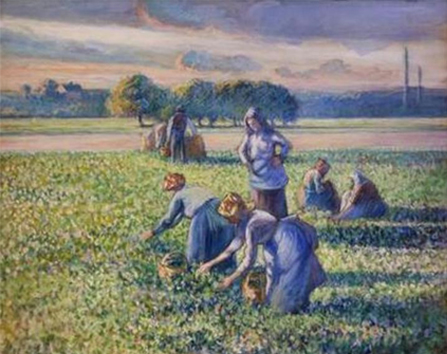
Returned to Jewish owners
A French impressionist painting looted by the Nazis is returned to the family that once owned it. A court in France ruled that it belonged to the descendants of Simon Bauer, an art collector. Picking Peas was painted in 1887 by Camille Pissarro.< In 1943, it was confiscated under anti-Semitic laws passed by the collaborationist Vichy government during the German occupation of France. Bauer, survived the war, but only because a strike by railwaymen stopped a train taking him to a concentration camp. Lost to the family, Picking Peas was bought for $800,000 (€690,000) at auction in New York in 1995 by Bruce and Robbi Toll./p>
Scottish Queen
Published: 2nd of November 2017
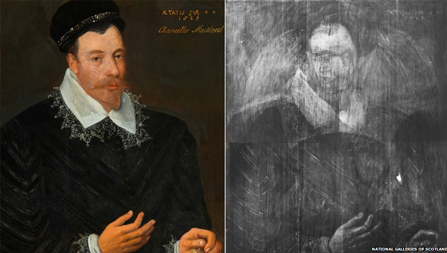
Ghostly Image of Scottish Queen Found Beneath Painting
Lurking behind an unassuming 16th century painting is one of the U.K.'s most controversial monarchs—Mary, Queen of Scots. While using X-rays to photograph a centuries-old painting of Scottish nobleman Sir John Maitland, art conservator Caroline Rae from the Courtald Institute of Art in London noticed the ghostly sketch of a woman beneath the top level of pigment. The woman can be seen wearing a dress and hat and appears to be looking off to the left. Tracing the woman's outline, Rae compared it to depictions of Mary made during this time period. She found it bore a strong resemblance to other paintings made of the queen.
Mona Lisa
Published: 28th of October 2017
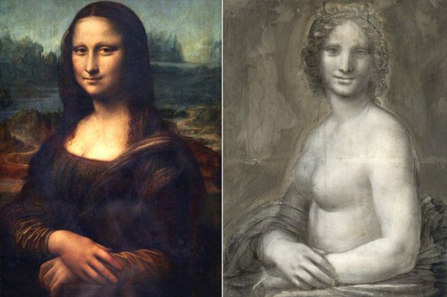
Mona Lisa nude sketch found in France
A charcoal drawing housed in another art collection for more than 150 years may have been a sketch for the Mona Lisa, a French art expert says. The charcoal portrait of a nude woman, known as the Monna Vanna, was previously attributed only to Leonardo da Vinci's studio. But experts have found enough clues to suggest the artist worked on both. After tests at the Louvre Museum in Paris, curators believe the sketch is "at least in part" by Leonardo.
Rubens found
Published: 28th of October 2017
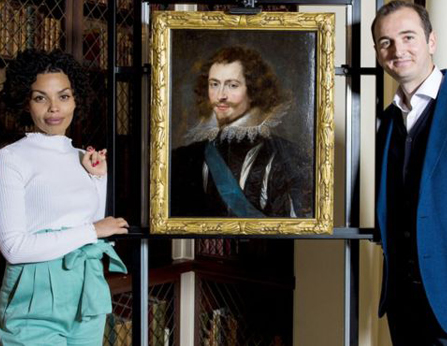
Rubens' Duke of Buckingham 'found' after 400 years
The 17th Century Flemish artist's "head study" of the Duke of Buckingham was identified by Dr Bendor Grosvenor from BBC Four's Britain's Lost Masterpieces. It was in Glasgow Museums' collection and on public display at the city's Pollok House stately home. But overpainting and centuries of dirt meant it was thought to be a later copy by another artist. The restored portrait of George Villiers, the 1st Duke of Buckingham, was authenticated as a Rubens by Ben van Beneden, director of the Rubenshuis in Antwerp.
Rare Monet
Published: 19th of September 2017
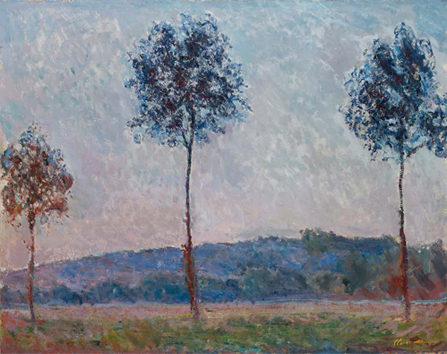
Trove of rare Monet artefacts to be sold at auction
Objects and artworks including artist’s spectacles, correspondence and a terracotta pot to be auctioned by Christie’s Previously unknown objects and artworks from the personal collection of Claude Monet, which have remained with the artist’s family, are to be sold at auction. The trove of objects includes artworks by Monet himself and his friends such as Édouard Manet, Auguste Rodin and Paul Signac; Japanese prints that he owned and that inspired him; and more personal items such as photographs,
Return of Stolen Art
Published: 11th of September 2017

"We should give back art looted by the Nazis"
The German food firm, Dr Oetker, has done more than many others to face up to its Nazi-era heritage. A few years ago, the family-owned firm enlisted prominent historians to write a book chronicling the relationship between former boss Rudolf-August Oetker - a member of the Waffen SS - and the Third Reich. It revealed how Dr Oetker had supported the war effort by providing pudding mixes and munitions to Nazi troops, and how the business had used slave labour in some of its facilities. Now, in a rarer move, the company is turning its attention to a more tangible reminder of former sins - its vast private art collection. In a floor-to-ceiling library at Dr Oetker's sprawling headquarters in the North-Rhine Westphalian city of Bielefeld, Dr Monika Bachtler reveals one of its treasures - a resplendent 17th Century silver goblet.
Saving Syria's heritage
Published: 11th of September 2017
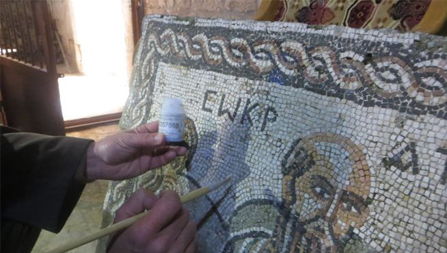
Archaeologists discover invisible solution
An ancient mosaic is painted with an invisible liquid that is detectable under ultra-violet light. The recent plundering of priceless artefacts from Syria and Iraq by both terrorists and criminal gangs has taken place on an unprecedented scale. Stolen items have been turning up in Europe and the US, where they have then been offered to private collectors. The UN heritage body Unesco says the illicit trade is worth millions of dollars. But an innovative solution may now be at hand which enables archaeologists to trace precious artefacts. Working in secret, in areas outside Syrian government control, Syrian archaeologists have begun painting some of the country's most valuable artefacts with a clear, traceable liquid. The solution is invisible to the naked eye, but detectable under ultra-violet light.
Read the full story
Poland secures bargain deal for Leonardo da Vinci and other works
Published: 25th of August 2017
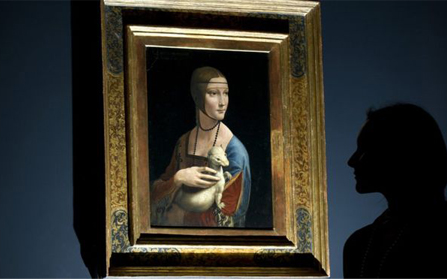
Mr Czartoryski: "I felt like making a donation and that's my choice. "
The Polish government has bought a world-famous art collection, including a rare Leonardo da Vinci painting, for a fraction of its market value. The Czartoryski collection was sold for €100m ($105m; £85m) despite being estimated at about €2bn. It includes Rembrandt and Renoir works, and Leonardo's Lady with an Ermine. The head of the Czartoryski family, which owned the collection, said it was a "donation", but the board of its foundation resigned in protest. The Czartoryski Foundation's management board said it was not consulted about the sale, which was negotiated between Poland's culture ministry and Adam Karol Czartoryski, a descendent of Princess Izabela Czartoryska, who founded the collection in 1802.
Son of Nazi governor returns art stolen from Poland during second world war
Published: 25th August 2017
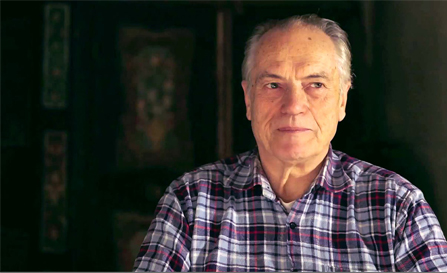
Horst Wächter: "I do not return the objects for me, but for the sake of my mother."
In December 1939 a Viennese woman with chestnut brown hair walked triumphantly into the National Museum in Kraków. Charlotte Wächter’s husband was the recently appointed Nazi governor of Kraków: SS Gruppenführer Otto Wächter; she was decorating the new headquarters that he had established at the city’s Potocki Palace – and in the process, she looted every department of the museum.
According to a Polish government assessment from 1946, Frau Wächter took “the most exquisite paintings and the most beautiful items of antique furniture, militaria, etc, despite the fact that the director of the museum had warned her against taking masterpieces for this purpose”.
Stolen Van Goghs back on display after years in criminal underworld
Published: 20th August 2017
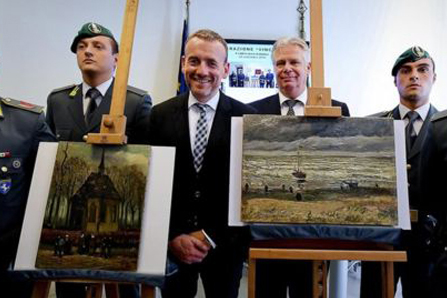
"The heist took about three minutes and 40 seconds," said convicted thief, Octave Durham.
They spent years under wraps and out of sight in a criminal's safe - but two Van Gogh paintings are now back on show in the Dutch museum they were stolen from in 2002. The canvases, Sea View at Scheveningen and Congregation Leaving the Reformed Church at Nuenen, date from Van Gogh's early period and are described as priceless. However, Dutch culture minister Jet Bussemaker said their real value would be in the eyes of those who can now see them again. Thieves seized the canvases from the Van Gogh Museum in Amsterdam - which contains the world's largest collection of Van Gogh works with more than 200 paintings and 500 drawings - after breaking in through the roof. One of the men convicted over the theft, Octave Durham, has revealed that he was actually after the artist's better known works, but they were harder to steal.
